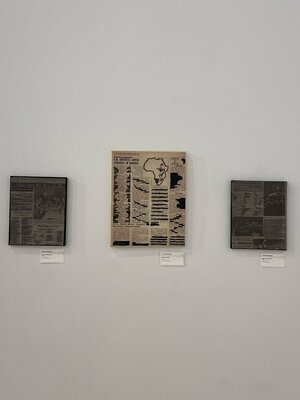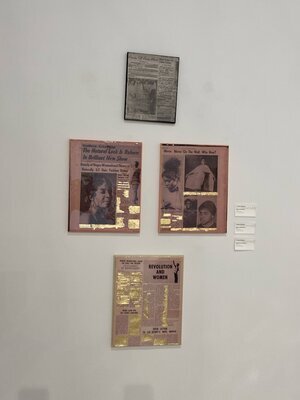When Black Panthers and The Nation Speaks
ROY presents: Cristyn Steward
Fri, Jun 12, 2020 - 6:00 PM
Sat, Jul 4, 2020 - 3:30 PM
As a filmmaker who revels in archivist history, curiosity lead me to read the newspapers made for Black people by Black people. Publications that refused to code switch, and aimed to educate. Each story blended truth with fact. As a poet who specializes in narrative and language poetry, in this exhibit I use the technique of Blackout poetry to highlight the language in The Black Panthers and Muhammed Speaks publications.
Growing up on 12th and Cleveland Avenues, I wonder what my childhood would have been like if there were The Black Panthers and Muhammad Speaks publications. How would I perceive myself, my family, my neighborhood? How would my gaze be affected had I been exposed to Black business owners? Not to be confused with the “diversity” of the 90s, I had the luxury of reading Essence, Jet and Ebony magazine.
Each poem is reimagined using black fine tip markers, strategically and impulsively redacting words to uncover the context and the subtext of over 50 articles in both publications. The film installation will be comprised of three, two-minute short films. Still photos and recreated articles cut together to create a chronological narrative of the evolution of both “The Panthers” and "The Nation.” As we journey through the timeline, we learn that the Black Panther Party for Self Defense and The Nation of Islam had very similar missions and we explore this is final short film “The Foundation.”
Born of the 80s and raised in the 90s, my leaders were hip hop lyricist educating the masses through cassette tapes and MC battles. However, The Black Panthers and the Nation of Islam demonstrated to us who we really are, a powerful people. We are a cultural reference for the United States and the globe. We are a community linked to the diaspora, building unity amongst countries like South Africa, Ghana, Brazil and Cuba. The leaders of these organizations intended to convey that we are more than Americans who come from slaves; we are the oppressors’ worst nightmare and our ancestors’ wildest dreams.
While the word installation is often used in the art world, as it refers to the process of setting up artwork, the word instillation, which uses an “i” instead of an “a”, often means to impart, or install knowledge into something or someone. Cristyn’s instillation will change over the course of the weeks of the exhibition imparting new insights for the viewer to experience a chronological narrative of the Black experience.
Week 1 “The Nation”
Week 2: "The Panthers"
Week 3: "The Foundation"
price upon request Artists receive 65% of sales and the 35% ROY retains is invested back into the gallery.
left > right
Black As We See It; Africa in Focus; Black As We See It
Black As We See It; Beauty of Blackness; Revolution and Women
Breakfast for the Children; Black As We See It; Suffer not!
Black Studies; Who Will Save the Negro
Panther Platform; Believe in the Nation
CRISTYN ANSWERS THE QUESTIONS ROY ASKS
WHAT IS YOUR NAME AND WHAT PRONOUNS DO YOU USE?
Cristyn A. Steward, She, Her
WHAT MEDIUM(S) DO YOU WORK WITH AND WHY?
I work with Film/Video and poetry. I use film/video because it is the best medium to use to tell a story, educate and entertain simultaneously. Poetry was my introduction to writing. I work with poetry because its history being tied to griots in West African culture.
HOW DID YOU BEGIN YOUR ARTISTIC PRACTICE?
I began using poetry when I was 13 and I have been experimenting with film and video since 2009. I was first exposed to poetry as an adolescence, intrigued by the voices and sounds of poetry I began to write my own stories using this medium. I started film by doing research on how to make a short film and after a year I had created my first two narrative shorts.
WHO/WHAT ARE SOME OF YOUR BIGGEST INFLUENCES OR INSPIRATIONS?
Some of my biggest inspirations are independent filmmakers from the 90s, John Singleton and Kasi Lemmons. Poets from the Black Arts Movement, Nikki Giovanni and Sonja Sanchez and the Harlem Renaissance writers, Langston Hughes and Zora Neale Hurston.
YOUR WORK SEEMS TO FOCUS ON REDACTION, COMMUNICATION, AND THE PROCESS OF ERASURE. COULD YOU SPEAK ON THAT?
The technique of black out poetry is to reveal the nuisances for the time period through the lens of both The Black Panther Party and the Nation of Islam. During the 60s and 70s, these organizations’ goal was to educated and provide a community for Black people.
WHAT KINDS OF INTERACTIONS DO YOU HOPE TO FOSTER BETWEEN YOUR WORK AND THE VIEWER?
My goal is get the viewer to think about code switching and how important representation is even at the when discussing print media and journalism. I also, want the audience to know the “real” story about how this organizations had a goal to enhance the Black community in the United States and globally.
WE LIVE IN A TIME WHERE SOCIAL MOVEMENTS LIKE BLACK LIVES MATTER ARE BEING BROUGHT TO THE FOREFRONT OF NATIONAL CONVERSATION. YOUR WORK DEALS WITH THE SAME PAIN PROTESTORS ARE SPEAKING OUT AGAINST. HOW MIGHT YOUR ART CHANGE OR ADAPT IN RESPONSE TO THIS?
Well, the Black Lives Matter movement has been a part of national conversation for over 5 years, the voices of the Black community have been suppressed and ignored for even longer. Police brutality and the militarization of the police is a battle Black people have fought for decades. When I intended this work, we were not in a state of civil unrest. We were comfortable living with the fact that white supremacy has always been a constant for Black people.
This work is poignant now because it reinforces the values and beliefs of the Black Panthers and the Nation of Islam from the beginning. They were right about police brutality. They were right about the inequities of health care, housing and the need for prison reform. They were right about the need to create Black economy to sustain Black communities.
I think this work will make huge connections for many people, educating them on America’s even more brutal past. In another respect this work will be a historical reference and outline to tackle white supremacy and systemic oppression.






